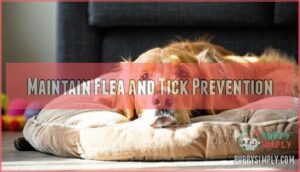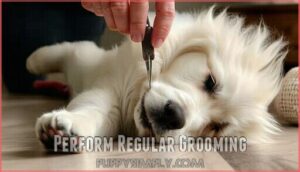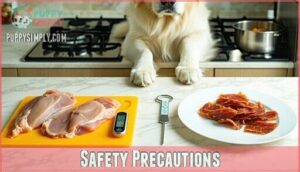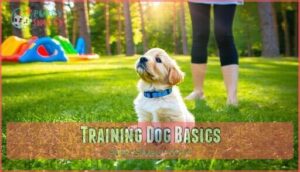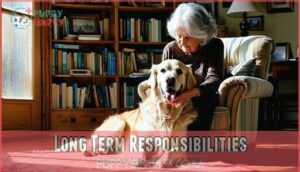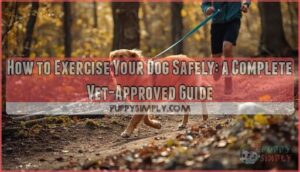This site is supported by our readers. We may earn a commission, at no cost to you, if you purchase through links.
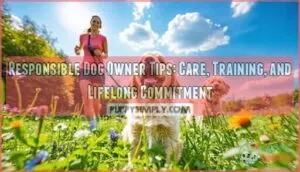
Training your dog using positive reinforcement creates good behavior that lasts a lifetime. Don’t forget to microchip your pet and keep ID tags updated—these simple steps can reunite you if your furry friend wanders off.
Clean up after your dog in public spaces and follow leash laws to maintain community goodwill. Remember, your commitment extends through all life stages, from playful puppy to senior companion.
The bond you build through consistent care becomes one of life’s most rewarding relationships.
Table Of Contents
- Key Takeaways
- Choosing Right Dog
- Daily Dog Care
- Safety Precautions
- Training Dog Basics
- Long Term Responsibilities
- Frequently Asked Questions (FAQs)
- What makes a responsible dog owner?
- What is the biggest responsibility of owning a dog?
- What’s the 90/10 rule for dogs?
- What are the qualities of a responsible pet owner?
- What are the legal implications of owning a dog?
- What are the financial costs of owning a dog?
- How do I choose the right dog for my lifestyle?
- What are the most effective ways to prevent dog bites?
- What types of activities are available with an AKC-registered dog?
- How to introduce new pets to existing ones?
- Conclusion
Key Takeaways
- You’ll need more than just love—responsible ownership demands regular vet care, proper nutrition, daily exercise, and consistent training using positive reinforcement.
- You’re making a lifetime commitment when you get a dog, so be prepared for care across all life stages, from energetic puppy years through senior dog needs.
- You’ll need to prioritize both physical and mental health through appropriate exercise, mental stimulation, and environmental enrichment tailored to your dog’s specific needs.
- You’re legally and socially responsible for your dog’s behavior, so ensure proper identification (tags and microchips), follow leash laws, and socialize your dog to prevent behavioral issues.
Choosing Right Dog
Picking the right dog isn’t just about looks—it’s about finding a companion that fits your lifestyle and needs.
Take your time, do your homework, and remember, the perfect match is worth the wait.
Assess Financial Commitment
Before diving into dog ownership, make sure your wallet’s ready. Dogs aren’t cheap!
Here’s a quick breakdown:
- Food Costs: Quality food adds up fast.
- Vet Expenses: Routine visits and emergencies can surprise you.
- Insurance Options: Consider dog health insurance for peace of mind.
Plan ahead, including grooming costs and an emergency fund, to guarantee lifelong pet care.
Evaluate Lifestyle Needs
Think about your time commitment, family dynamics, and hobbies before jumping into dog ownership.
A high-energy dog might clash with a quiet home, while a couch potato pup won’t fit an active lifestyle.
Consider your home environment and activity levels.
Matching a dog’s needs with your daily life guarantees smoother pet care, better dog behavior, and happier dog training sessions.
Research Breeds Thoroughly
Choosing the right dog starts with thorough research.
Dog breeds vary in temperament, health, and care needs.
Focus on these key factors:
- Breed Temperament: Does it match your lifestyle?
- Breed Health: Are there common issues?
- Grooming Needs: High-maintenance or low?
- Exercise Requirements: Active or relaxed?
- Breed History: Understand its original purpose.
Smart breed selection guarantees a happy match!
Consider Older Dogs
Senior dogs offer overlooked companionship and often come with lower energy needs, making them perfect for calmer households.
Many are pre-trained, giving you the advantage of skipping puppy basics.
Adopting a rescue dog creates an instant bond while giving them a second chance.
Plus, their loyalty and wisdom can enrich your life, even if their dog longevity ends naturally.
Daily Dog Care
Caring for your dog each day keeps them happy, healthy, and full of energy. From meals to grooming, a little effort goes a long way in building a strong bond.
Schedule Regular Veterinary Checkups
Keeping up with wellness exams is like a checkup for your dog’s happiness.
Regular vet care guarantees vaccination schedules and parasite prevention stay on track.
These visits help with early detection of health issues, giving you peace of mind.
Preventative care isn’t just smart—it’s essential for dog health.
Remember, consistent dog veterinary care keeps tails wagging and hearts healthy!
Provide Balanced Diet and Exercise
Every dog thrives on balanced dietary guidelines and regular exercise.
Tailor dog food to breed specifics, activity levels, and health needs. Manage weight with portion control and vet-approved dog supplements.
A healthy dog requires complete nutritional support to boost dog health and happiness.
Encourage daily exercise to work wonders for weight management and dog exercise—plus, it’s quality bonding time!
Maintain Flea and Tick Prevention
Fleas and ticks aren’t just annoying—they can spread diseases like Lyme.
Break the flea lifecycle with preventative options like collars or spot-on treatments.
Consult your vet for safe application methods suited to your dog’s needs.
Environmental control matters too—regularly clean your dog’s bedding and yard.
Prioritizing pet safety and canine health keeps both you and your pooch happy.
Regular bathing helps with this, but be mindful of dog washing frequency to avoid skin issues, ensuring overall canine health.
Perform Regular Grooming
Grooming keeps your dog healthy and happy. Start with regular coat brushing to reduce shedding and mats.
Follow these essentials:
- Trim nails every 2-4 weeks to prevent discomfort.
- Clean ears gently to avoid infections.
- Brush teeth daily for better mouth health.
- Use proper grooming tools suited to your dog’s needs.
Consider using appropriate dog nail clippers for safe trimming. Your pup will thank you with wagging tails and be happy!
Safety Precautions
Keeping your dog safe is all about being prepared and staying alert.
From ID tags to secure leashes, simple steps can prevent mishaps and keep your furry friend out of trouble, which is a key part of being prepared.
Equip Dogs With ID Tags
Ever wondered how to keep your pup safe if they wander off?
Equip your dog with identification tags and consider a microchip.
Tags should include your contact info, fit securely on the collar, and be easily readable.
A microchip adds extra safety, helping shelters reunite lost pets with owners.
Legal requirements often mandate dog identification.
Many owners choose reflective dog collars for increased visibility during nighttime walks.
| Tag Material | Durability | Visibility | Best Placement |
|---|---|---|---|
| Aluminum | Lightweight, affordable | High | Collar |
| Stainless Steel | Long-lasting | Medium | Collar |
| Plastic Tags | Quiet, colorful | High | Collar |
| Microchip | Permanent, tamper-proof | Invisible | Internal |
Use Travel Crates or Seat Belt Harnesses
Keeping your dog safe during travel is a must.
Use a crate or harness to prevent injuries and distractions.
Here’s how to guarantee car safety:
- Choose a durable, crash-tested crate for secure transport.
- Pick harness types designed for vehicle restraint.
- Follow accident prevention tips like proper seat placement.
- Meet legal requirements for dog safety in vehicles.
Many owners find that a dog travel crate provides the best protection.
A durable crate and proper restraint are essential for safe travel.
Create Disaster Plan and Emergency Kit
When disaster strikes, you’ll want a dog evacuation kit ready.
Pack food storage, first-aid essentials, and water for your pup. Don’t forget updated emergency contacts, a microchip, and clear dog identification methods.
Include items like familiar toys for comfort.
Plan evacuation routes, shelter options, and practice drills.
Dog emergency preparedness guarantees safety, even in chaotic moments.
Secure Yards or Use Leashes
After planning for emergencies, focus on keeping your dog secure daily.
Leash laws exist for public safety, so a sturdy dog leash is a must on walks.
At home, proper fence types prevent escapes and dog stray prevention, which benefits include escape prevention and peace of mind.
Whether using a dog fence or leash, prevent accidents and respect others.
Training Dog Basics
Training your dog is about building a foundation of trust and good behavior that lasts a lifetime.
With consistency, patience, and plenty of praise, you’ll help your pup learn and thrive, which is a complete concept that encompasses the entire process of dog training.
Teach Basic Commands and Obedience
Teaching basic commands like sit, stay, and come helps build trust and improves dog manners.
Use Positive Reinforcement—treats, praise, and belly rubs work wonders.
Practice Recall Training for safer, stress-free walks, and tackle Problem Behaviors early with crate training.
Dog training methods like leash manners and dog training classes also make obedience fun and rewarding for both of you.
Consistent hand signals can further enhance communication.
Socialize Dogs With People and Environments
Early socialization shapes confident, well-mannered dogs.
Start by exposing puppies to people, pets, and noises in a positive way.
Use a simple socialization checklist—like meeting neighbors or visiting pet-friendly spots.
Fear management is key; avoid overwhelming your dog.
For handling reactivity, reward calm behavior during dog interactions.
Positive exposure early on builds trust, easing your dog’s neighborhood integration.
Enroll in Obedience Classes
Dog obedience classes offer more than sit-and-stay skills.
They help with dog training by addressing problem behaviors, building confidence, and sharpening socialization skills.
Puppy classes or advanced training sessions create a safe space for learning, ensuring positive training experiences.
Enrolling nurtures stronger bonds between you and your pup while teaching practical socialization that’s priceless for everyday life.
Use Positive Reinforcement and Praise
With dog training, rewarding desired behaviors is like planting seeds for a well-mannered pup.
Use positive reinforcement tools, like treats or praise, to shape dog behavior effectively.
Remember, consistency is key—dogs thrive on clear, positive training cues.
Avoiding punishment keeps training engaging and builds trust.
Try these dog training tips, and you’ll nurture obedience while strengthening your bond.
Long Term Responsibilities
Owning a dog means committing to their care for their entire life, through all stages and challenges.
You’ll need to prioritize their health and happiness while planning for their needs, even in difficult times.
Commit to Dog’s Care for Entire Life
Dog ownership is a long-term commitment.
Life happens—financial planning helps handle unexpected hardship. As a responsible dog owner, you’ll care for your pup through every stage, from playful youth to an aging dog needing extra attention.
End-of-life care is tough but essential for dog responsibility. Your loyalty guarantees they feel loved, comforted, and safe their entire life.
Prioritize Physical and Mental Health
Your commitment to your pet goes beyond lifetime care.
Your furry friend’s happiness depends on balancing mental enrichment with physical activity.
Provide daily exercise suited to breed needs—at least 3 hours of walks or play.
Don’t forget mental stimulation through training games.
Preventative care includes regular dental care and appropriate health supplements.
Quality dog nutrition supports overall wellbeing, while consistent emotional support helps your companion thrive through all life stages, ensuring a long and happy lifetime.
Manage Fears and Behaviors Positively
Through patient guidance, you’ll help your nervous pup overcome fears.
When your dog shows anxiety, identify their triggers and use positive reinforcement to create new associations. Don’t punish fearful reactions—this only increases stress.
Instead, employ calming techniques like controlled exposure to scary situations. With consistent behavior modification, even naturally anxious dogs can become more confident.
Medications like SSRIs and benzodiazepines can be prescribed by veterinarians as part of a thorough dog fear anxiety treatment.
Remember, addressing dog aggression early prevents long-term problems and improves socialization opportunities.
Plan for End-of-Life Care and Decision Making
Facing end-of-life decisions for your furry companion requires compassionate planning. When considering your dog’s final journey, remember these essential steps:
- Assess quality of life regularly using veterinarian-recommended scales
- Explore palliative and hospice care options for comfort
- Research euthanasia decisions with your support network
- Consider aftercare options like cremation or burial
- Create legacy planning to honor your pet’s memory
Don’t wait until crisis—having these conversations early helps guarantee your decisions come from love, not panic, and allows for proper planning and respectful care for your pet.
Frequently Asked Questions (FAQs)
What makes a responsible dog owner?
Like a captain steering a ship, you’re responsible when you provide proper healthcare, training, and love.
You’ll guarantee safety, meet exercise needs, offer regular vet care, and commit to your dog’s wellbeing for life.
What is the biggest responsibility of owning a dog?
The lifelong commitment to your dog’s physical and emotional wellbeing stands as your greatest responsibility.
You’ll need to provide daily care, veterinary attention, training, and love throughout your pet’s entire life.
What’s the 90/10 rule for dogs?
Just as a chef balances ingredients for perfect flavor, the 90/10 rule means you’ll give your dog 90% positive reinforcement (treats, praise) and only 10% correction when training. This creates well-behaved, happy companions.
What are the qualities of a responsible pet owner?
You’ll provide daily care, regular vet visits, proper nutrition, exercise, training, and socialization for your pet.
You’ll guarantee safety through identification, create emergency plans, and commit to their lifetime wellbeing with love and respect.
What are the legal implications of owning a dog?
You’ll need to comply with licensing laws, leash requirements, and noise ordinances.
You’re liable for any damage or injuries your dog causes, and you must maintain proper identification and vaccinations for your pet.
What are the financial costs of owning a dog?
You’ll spend about $1,500 initially for adoption, supplies, and medical care. Annually, you’ll need $1,000-$1,500 for food, routine vet visits, grooming, and toys. Emergency medical situations can add significant costs.
How do I choose the right dog for my lifestyle?
Consider compatibility carefully when choosing a canine companion.
Match your activity level, living space, and available time with the breed’s exercise needs, size, and temperament.
Research breeds thoroughly and visit shelters to find your perfect fit.
What are the most effective ways to prevent dog bites?
Teach your dog proper socialization, learn to read canine body language, and supervise interactions with children. Always ask before petting someone’s dog, and never approach unfamiliar dogs without owner permission.
What types of activities are available with an AKC-registered dog?
You’ll enjoy conformation shows, obedience trials, agility competitions, rally, tracking, herding, field trials, and therapy work with your AKC dog.
There’s also Canine Good Citizen testing and the popular sport of dock diving.
How to introduce new pets to existing ones?
Like merging two rivers, introduce pets gradually.
Keep initial meetings short and supervised. Swap bedding to share scents first.
Use treats as positive reinforcement and provide separate spaces until they’re comfortable together.
Conclusion
Like Odysseus returning home to his faithful dog Argos, your journey as a responsible dog owner creates an unbreakable bond.
Remember, the daily efforts you make—providing proper nutrition, consistent training, regular vet visits, and endless love—shape your pet’s happiness and health.
By maintaining these commitments through all life stages, you’ll enjoy a rewarding companionship that enriches both your lives.
Your dedication as a responsible dog owner isn’t just appreciated by your furry friend—it’s their lifeline.
- https://marketplace.akc.org/puppies
- https://retrievist.akc.org/essentials/thoughtful-gifts-for-dog-lovers/
- https://www.akcreunite.org/cares-pub/microchip/home.car
- https://www.apps.akc.org//apps/helpline/index.cfm
- https://www.theguardian.com/food/2023/jun/04/the-parakeet-london-the-food-is-great-but-beware-of-the-dogs-restaurant-review







